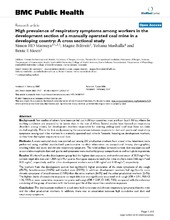| dc.description.abstract | Background: Few studies of miners have been carried out in African countries; most are from South Africa, where the working conditions are assumed to be better than in the rest of Africa. Several studies have focused on respiratory disorders among miners, but development workers responsible for creating underground road ways have not been studied explicitly. This is the first study assessing the associations between exposure to dust and quartz and respiratory symptoms among coal mine workers in a manually operated coal mine in Tanzania, focusing on development workers, as they have the highest exposure to coal dust. Methods: A cross-sectional study was carried out among 250 production workers from a coal mine. Interviews were performed using modified standardized questionnaires to elicit information on occupational history, demographics, smoking habits and acute and chronic respiratory symptoms. The relationships between current dust exposure as well as cumulative respirable dust and quartz and symptoms were studied by group comparisons as well as logistic regression. Results: Workers from the development group had the highest dust exposure, with arithmetic mean of 10.3 mg/m3 for current respirable dust and 1.268 mg/m3 for quartz. Analogous exposure results for mine workers were 0.66 mg/m3 and 0.03 mg/m3, respectively; and for other development workers were 0.88 mg/m3 and 0.10 mg/m3, respectively. The workers from the development section had significantly higher prevalence of the acute symptoms of dry cough (45.7%), breathlessness (34.8%) and blocked nose (23.9%). In addition, development workers had significantly more chronic symptoms of breathlessness (17.0%) than the mine workers (6.4%) and the other production workers (2.4%). The highest decile of cumulative exposure to respirable dust was significantly associated with cough (OR = 2.91, 95% CI 1.06, 7.97) as were cumulative exposure to quartz and cough (OR = 2.87, CI 1.05, 7.88), compared with the reference consisting of the group of workers with the lowest quartile of the respective cumulative exposure. Conclusion: The development workers in a coal mine had more acute and chronic respiratory symptoms than the mine and the other production workers. In addition, there was an association between high cumulative coal dust and respiratory symptoms. | en_US |
